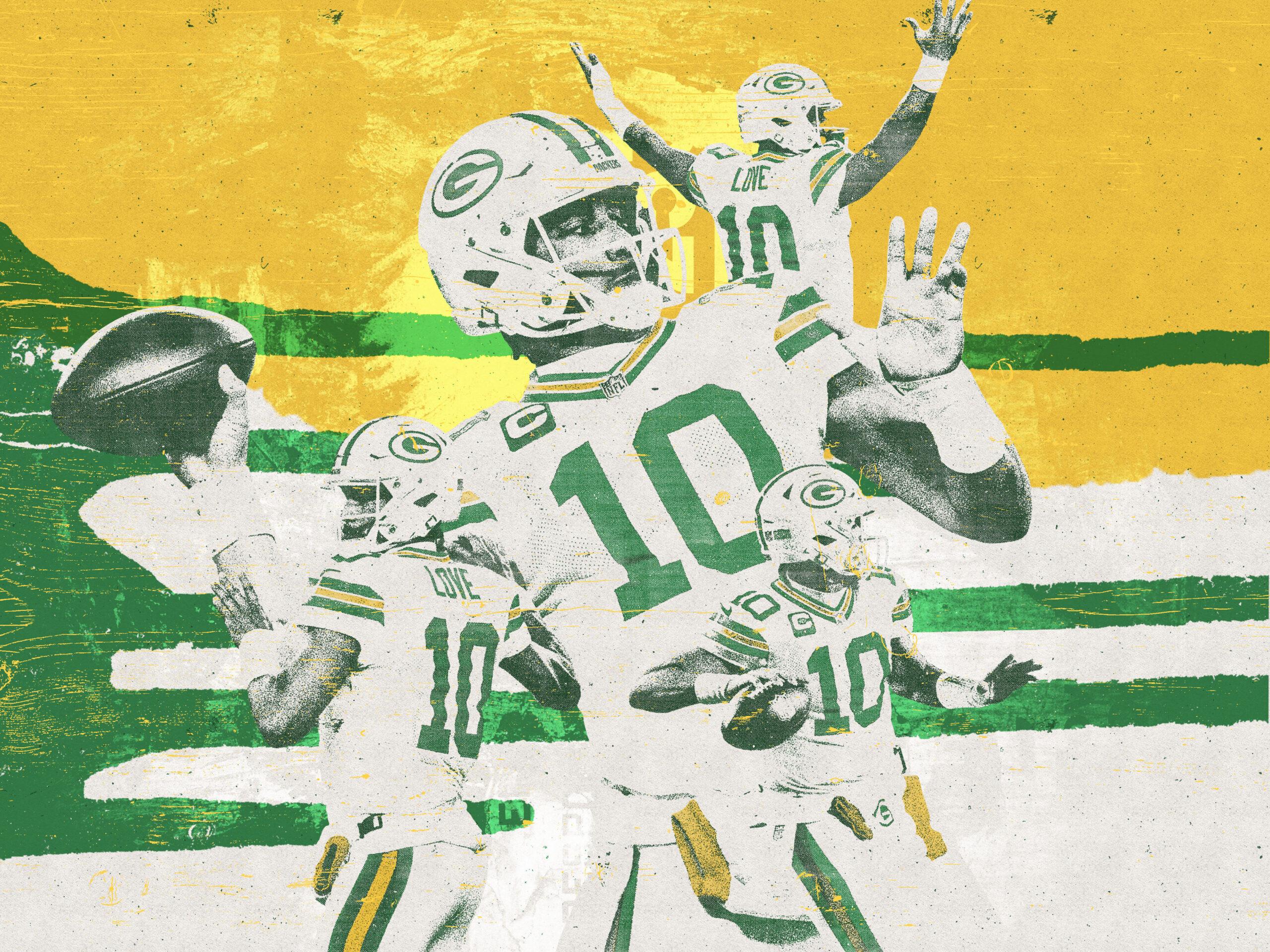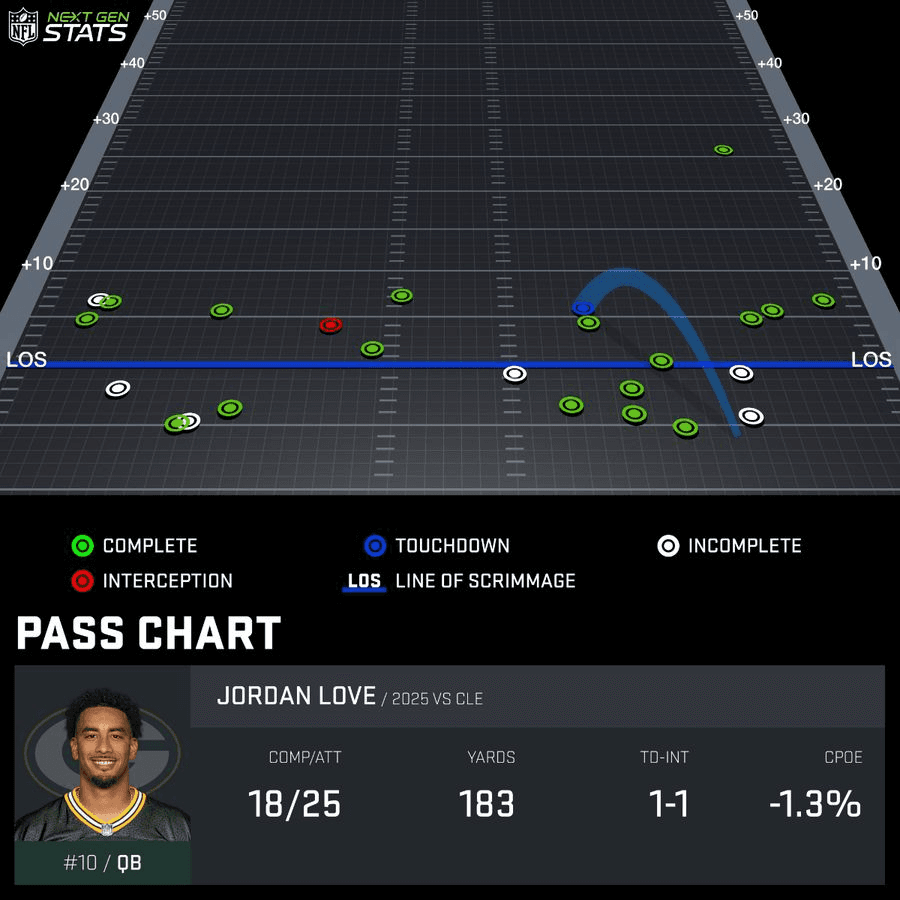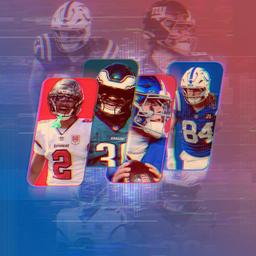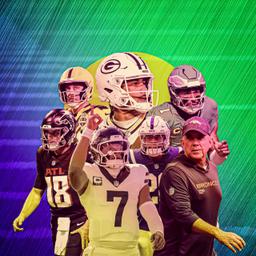
Jordan Love’s MVP campaign officially launched on Sunday night, when the Green Bay Packers quarterback torched the Steelers for 360 yards and three touchdowns in a 35-25 win. It was Love’s most complete performance of the season, especially in the second half, when he completed 20 passes in a row—many of which were throws that only he’d be willing to attempt. The win moved Green Bay to 5-1-1 on the season, which leads the NFC, and the fact that it came in front of a national audience helped vault Love to fifth in MVP odds, behind Patrick Mahomes, Josh Allen, Drake Maye, and Matthew Stafford.
The win didn’t just boost Love’s profile across the league; it also validated head coach Matt LaFleur’s growing trust in his quarterback. That trust was on full display the week prior, when LaFleur initially sent out the field goal unit late in a tight game against Arizona, only to change his mind after seeing the look on Love’s face. “When our quarterback’s coming off [the field] and I can see the disdain on his face,” LaFleur said, “it was just one of those deals where I was like, ‘No matter what we call, this guy’s gonna make it work.’”
LaFleur called a timeout, sent his offense back out, and asked his quarterback to go win the game. The Cardinals covered up the initial reads on the play, blanketing the two underneath options to Love’s left, so he adjusted and found tight end Tucker Kraft on a deeper route for 15 yards. As LaFleur predicted, Love made it work. Three plays later, Josh Jacobs found the end zone for the game-winning score.
Love has earned the belief of his coach, but he’s still trying to convince certain doubters in national media, including Rex Ryan, the NFL coach turned ESPN analyst who ripped Love ahead of Packers-Steelers. “Yes, he's got unbelievable ability, and we'll see some amazing plays from him,” Ryan said. “But at the end of the day, do I trust Jordan Love? No, I don't. Statistically, it says he doesn't turn the ball over. Oh yes, he does. The biggest moments, he'll turn it over.”
Even with Love coming through in the clutch against Arizona and delivering a memorable performance against Aaron Rodgers’s Steelers in a big spot, Ryan’s skepticism about Love isn’t totally unfounded. While the 26-year-old quarterback has generally protected the football throughout his two-plus seasons as a starter in Green Bay, he’s thrown five interceptions in his past two playoff appearances—both losses. And although he hasn’t racked up a ton of regular-season picks, he has thrown some ugly ones, contributing to the feeling that Love can be reckless with the football—a trait that you don’t typically find in a winning quarterback. Both of his interceptions this season fall into that genre. His first directly led to the team’s lone loss of the season, a 13-10 defeat to the hapless Browns.
And Love could have avoided his second pick, which came against the Bengals, if he had just thrown the ball away. Instead, he tried to salvage a broken play and tossed a dangerous pass into coverage.
Those were ugly moments in an otherwise brilliant start to Love’s third season at the helm of the Packers offense. Green Bay doesn’t throw a lot, so Love’s counting stats aren’t overwhelming—he ranks ninth in the NFL in passing yards and is tied for 11th in touchdowns—but he’s been an efficiency monster, ranking second in EPA per dropback, third in yards per dropback, and fourth in success rate, per TruMedia.
The Packers are winning, the offense is humming, and Love finds himself in the thick of the MVP race. But with Green Bay eyeing another playoff run, we still don’t have an answer to the question Ryan posed: Can we trust Love in the biggest moments? That kind of faith isn’t earned through one stellar Sunday night performance or a string of clean box scores; it’s earned with consistency. So let’s take a closer look at how Love has improved his game in 2025 and try to figure out whether he can sustain that long enough to lead Green Bay on a deep playoff run.
Through the first two months of the 2025-26 season, Love has been the NFL’s best quarterback in pass downs. He’s tied with Daniel Jones for the league lead in EPA per dropback but holds an advantage over him in yards per dropback and success rate. When you focus on third-and-pass situations (when a team needs at least 4 yards to gain a first down), Love stands out even further. He’s leading the league in total EPA, success rate, and yards per dropback. Love’s numbers are up across the board, but his pass-down performance has seen the most significant growth year over year.
He wasn’t so good in those same situations in 2024, when he finished 26th in success rate at 34.3 percent. What’s interesting is that Love hasn’t altered his approach on those downs. He’s got an identical average time to throw and average depth of target compared to last year, and when you study his tape, you can see that he’s attempting similar throws—he’s just better at making them now. His off-target throw rate is 7 percent, down from 18 percent in 2024.
As impressive as the numbers are, you have to watch Love’s work in obvious passing situations to fully appreciate them. He’s as entertaining a quarterback as there is in the NFL—especially if you’re a fan of the old guard of passers who’d hang in the pocket and sling the ball downfield. Love is going to try some shit. Packers receiver Jayden Reed once compared his fadeaway throws to something you’d see from Kobe Bryant or Michael Jordan on a basketball court. No one was better at getting a bucket when they needed one. And this season, Love is emerging as one of the NFL’s top bucket getters. That was on full display against the Steelers.
In that game, Love made at least two daring back-foot throws to move the chains on third down, including this 59-yard pass to Kraft.
That throw isn’t nearly as reckless as it appears. Love said after the game that he knew the Steelers were in man coverage, and with the defender’s back to the pocket, Kraft had a good chance of coming down with the ball—if only Love could get it to him.
Love’s 33-yard heave to Christian Watson later in the third quarter was a bit luckier but was even more impressive from a physical standpoint. It required Love to muscle a back-foot fadeaway over the head of a safety and into Watson’s arms.
Love is also making impressive throws in structure. This Week 1 touchdown to Kraft against the Lions required quick decision-making and tight-window precision.
It’s also another example of Love seeing a defender’s back as a green light to make a throw. That’s next-level processing and something only top quarterbacks are capable of.
Love would probably like to burn the tape from the Cleveland game, but this was a tremendous throw that illustrates why defenses have such a hard time against him on third down. The Browns are in a Cover 2 defense, with the deep safety to Love’s right playing a little closer to the middle of the field. The ball is on the left hash, so that safety isn’t expecting Love to have the time—or ambition—to make a vertical throw all the way over to the right sideline. Welp.
The Browns were daring Love to make that throw, thinking that he didn’t have the audacity or ability to pull it off. That was a miscalculation.
There are also plenty of examples in Love’s tape of him making more routine throws. Those plays aren’t nearly as fun to watch, but as indicators of his development, they’re just as encouraging as the deep shots. This one, from the Week 1 win over the Lions, is similar to the key fourth-down play in Arizona. Detroit blankets Love’s first two options to his left, so he calmly works to the backside of the play and finds Dontayvion Wicks beyond the first-down marker on third-and-10.
This one’s from Sunday night, and it isn’t nearly as easy as it looks. Steelers safety Juan Thornhill starts in the deep middle but rotates down to the right flat area. Love instantly recognizes the rotation and layers a pass over Thornhill’s head to hit Romeo Doubs on a 10-yard out from the far hash.
That play requires good timing, quick processing, and both touch and accuracy. Those hadn’t been hallmarks of Love’s game through his first two years as a starter. In 2025, though, they’ve become foundational features for the Packers quarterback. The maturation of Love’s game has led directly to the improvements we’ve seen in must-pass situations—and even if some of his outrageous throws aren’t repeatable, we’ve seen enough sustainable progress to believe that he’s turned a corner as a dropback passer.
Love’s statistical improvement shows where he’s made gains as an individual. But the jump in his early-down production probably says more about his improved surroundings. Green Bay’s run game has been up and down this season, but it’s helped foster one of the league’s most productive and explosive play-action pass attacks. The Packers lead the NFL at 0.48 EPA per play on play-action, per TruMedia. And with Green Bay’s deep receiver room, Love has an abundance of options to throw to after a play fake. Plus, when defenses drop deep into coverage to take downfield options away, Love has maybe the best outlet option in the league in Kraft, who can start a play as a blocker, release to the flat as an outlet option, and create an explosive play after the catch.
Per TruMedia, the third-year tight end ranks ninth in the NFL in total EPA generated on play-action passes while ranking 199th in average depth of target. Love typically pushes the ball downfield on third-and-long, but the Packers have (successfully) used Kraft as a screen option in those situations as well. He gained two first downs on screen passes in Green Bay’s Week 4 tie against Dallas.
If there’s a criticism to be leveled against this offense, it’s that LaFleur has been a little too protective of his quarterback on early downs. Green Bay’s offense is one of the more run-heavy units in the NFL, and even when Love does pass on first or second down, it’s typically a shorter, safer throw. His 6.5-yard aDOT on early downs ranks 23rd in the NFL. The Packers coach and offensive play caller has a (somewhat annoying) tendency to call a run play after a first-down pass falls incomplete. Green Bay’s 40 percent run rate after a first-and-10 incompletion is nearly 10 full percentage points over the league average, per Pro Football Focus. Even after explosive gains through the air, LaFleur can get a little conservative, running the ball on the next play 60.5 percent of the time, compared with the league average of 47 percent.
It’s difficult to say whether that speaks to a lack of faith in his quarterback or is just a quirk of LaFleur’s play calling, but it was the biggest contributor to Green Bay’s shocking loss to Cleveland. While Love’s poorly timed interception and a late blocked field goal didn’t help, the game would not have been so close had the Packers offense kept its foot on the gas. LaFleur called plays as if he were deathly afraid of Myles Garrett and the Browns pass rush. The Packers’ 56.8 percent early-down run rate was easily their highest of the season. They called screen passes on over 10 percent of their plays. And Love’s aDOT was a comically low 1.9 yards. He attempted one pass over 8 air yards. Green Bay didn’t beat Cleveland because LaFleur never really tried to.

If Love is going to fully win over pundits like Ryan and lock in his spot in the MVP race, he’ll have to produce some high-profile performances against better defenses. There’s no way around it: Love has built his MVP campaign by beating up on a rogues’ gallery of crappy units. The Cowboys and Bengals have the two worst defenses in the league by EPA. Pittsburgh ranks 26th, Washington is 25th, and Arizona is 21st. Love did play well against Detroit’s third-ranked defense in Week 1, but the Lions had an uncharacteristically bad performance in their first game under new coordinator Kelvin Sheppard. That makes the red-flag performance against Cleveland even harder to ignore.
Love will have plenty of chances to show that he can keep this up against top defenses over the last two months of the season. After a winnable game against Carolina on Sunday, the Packers start a four-game stretch that includes matchups against the Eagles, Vikings, and Lions. If Love can carve up those defenses like he did with the weaker ones, he could emerge as the leading candidate for MVP.
He has the team success and efficiency metrics you typically see out of a top candidate, but so far he lacks the volume. Mahomes, Maye, and Stafford all rank ahead of him in passing yards and touchdowns. As Love earns more leeway from LaFleur, he should get more opportunities to pad his counting stats and catch up to his competitors. And if the fourth-down moment in Arizona showed that LaFleur is willing to trust Love in certain spots, the game plan against the Steelers doubled down on that. While the teams’ results have been very different, Cleveland and Pittsburgh play similar styles of defense, setting wide edges on the defensive line and playing a lot of man coverage with only a single safety deep. The goal is simple: to load up against the run and force the offense to throw into tight windows downfield. Both defenses are designed to take away the “schemed-up” plays that an offense like Green Bay prefers to run on early downs. While LaFleur played it safe against Cleveland, he took a different approach in Pittsburgh, as he explained after the game.
“I just can’t guarantee where the ball is going to go unless we’re calling a jet sweep or a screen,” he said on Sunday night. “That wasn’t a good team to run those types of plays against because they were so wide with their edges, … so when you watched them on tape, they weren’t effective. What was more effective was dropping back and throwing the football—kind of like Cincinnati did [against them].”
Whether it was the fact that Love came through on fourth down against the Cardinals or that LaFleur watched a 40-year-old Joe Flacco pick the Steelers defense apart, the coach felt more comfortable putting the game on his quarterback’s shoulders. And that trust should only grow after Love’s performance on Sunday. The third-year starter has delivered in big moments this season and thrived in the most challenging situations a quarterback can face. If he can continue that in the season’s second half, he could position himself—and his team—to earn some pretty impressive hardware.




